1 of 10
Downloaded 42 times

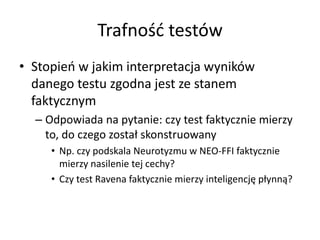
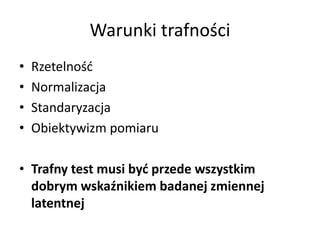
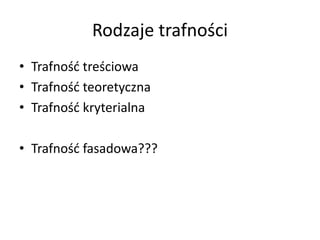
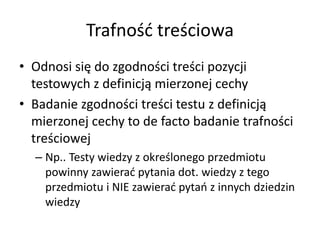

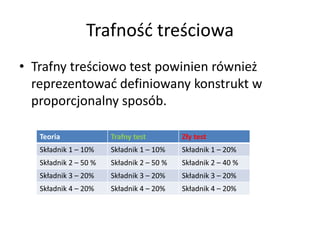

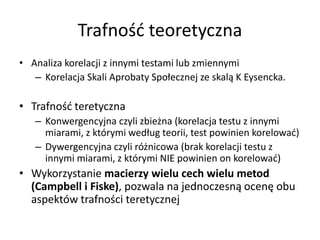
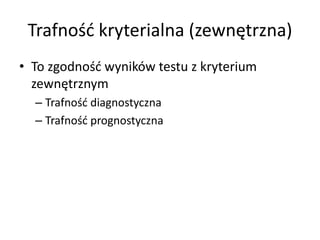
Ad
Recommended
Metodologia badaЕ„ psychologicznych - zajД™cia 3 - eksperyment, badanie korelac...
Metodologia badaЕ„ psychologicznych - zajД™cia 3 - eksperyment, badanie korelac...Karol Wolski
Мэ
eksperyment, quasi-eksperyment, zasada randomizacji, plan Solomona, plan z powtarzanymi pomiarami, plan czynnikowy, plan jedno-jednozmiennowy, model korelacyjnyMetodologia badaЕ„ psychologicznych - zajД™cia 6 - DobГіr prГіby, trafnoЕ›Д‡ wewnД™t...
Metodologia badaЕ„ psychologicznych - zajД™cia 6 - DobГіr prГіby, trafnoЕ›Д‡ wewnД™t...Karol Wolski
Мэ
techniki projekcyjne w diagnozowaniu sytuacji rodzinnej i szkolnej
techniki projekcyjne w diagnozowaniu sytuacji rodzinnej i szkolnejЕ»aneta Kozubek
Мэ
techniki projekcyjne w diagnozowaniu sytuacji rodzinnej i szkolnejPodstawy statystyki dla psychologГіw - zajД™cia 5 - korelacja
Podstawy statystyki dla psychologГіw - zajД™cia 5 - korelacja Karol Wolski
Мэ
Korelacja, wykres rozrzutu, korelacja a predykcja, wspГіЕ‚czynnik korelacji Pearsona, wspГіЕ‚czynnik korelacji rangowejArteterapia jako metoda pracy z osobami z autyzmem
Arteterapia jako metoda pracy z osobami z autyzmemAlicja Wujec Kaczmarek
Мэ
art therapy for autistic childrenDobГіr prГіby i schematy doboru prГіby - schematy losowe - indywidualny, systema...
DobГіr prГіby i schematy doboru prГіby - schematy losowe - indywidualny, systema...Radek Oryszczyszyn
Мэ
MateriaЕ‚y na zajД™cia "DobГіr prГіby w badaniach", Instytut Socjologii Uniwersytet w BiaЕ‚ymstokuSpoЕ‚eczna psychologia rozwoju dzieci i mЕ‚odzieЕјy 3
SpoЕ‚eczna psychologia rozwoju dzieci i mЕ‚odzieЕјy 3Martinez1986pl
Мэ
SpoЕ‚eczna psychologia rozwoju dzieci i mЕ‚odzieЕјy 3Podstawy statystyki dla psychologГіw - zajД™cia 6 - predykcja
Podstawy statystyki dla psychologГіw - zajД™cia 6 - predykcjaKarol Wolski
Мэ
Predykcja, równanie linii regresji, standardowy błąd oszacowania, homoskedastyczność, heteroskedastycznośćDual credit psychology notes chapter 13 – psychological testing
Dual credit psychology notes chapter 13 – psychological testingmrslocomb
Мэ
Psychological tests aim to reliably and validly measure constructs like intelligence, personality, interests, and abilities. Intelligence tests assess general mental abilities and specific skills, with theories proposing single or multiple factors of intelligence. Personality tests evaluate characteristics and problems through objective questionnaires or projective techniques interpreting ambiguous stimuli. Achievement and aptitude tests respectively measure learning and predict skill acquisition. Psychological testing provides standardized assessment with norms, though factors like culture must be considered.More Related Content
What's hot (20)
techniki projekcyjne w diagnozowaniu sytuacji rodzinnej i szkolnej
techniki projekcyjne w diagnozowaniu sytuacji rodzinnej i szkolnejЕ»aneta Kozubek
Мэ
techniki projekcyjne w diagnozowaniu sytuacji rodzinnej i szkolnejPodstawy statystyki dla psychologГіw - zajД™cia 5 - korelacja
Podstawy statystyki dla psychologГіw - zajД™cia 5 - korelacja Karol Wolski
Мэ
Korelacja, wykres rozrzutu, korelacja a predykcja, wspГіЕ‚czynnik korelacji Pearsona, wspГіЕ‚czynnik korelacji rangowejArteterapia jako metoda pracy z osobami z autyzmem
Arteterapia jako metoda pracy z osobami z autyzmemAlicja Wujec Kaczmarek
Мэ
art therapy for autistic childrenDobГіr prГіby i schematy doboru prГіby - schematy losowe - indywidualny, systema...
DobГіr prГіby i schematy doboru prГіby - schematy losowe - indywidualny, systema...Radek Oryszczyszyn
Мэ
MateriaЕ‚y na zajД™cia "DobГіr prГіby w badaniach", Instytut Socjologii Uniwersytet w BiaЕ‚ymstokuSpoЕ‚eczna psychologia rozwoju dzieci i mЕ‚odzieЕјy 3
SpoЕ‚eczna psychologia rozwoju dzieci i mЕ‚odzieЕјy 3Martinez1986pl
Мэ
SpoЕ‚eczna psychologia rozwoju dzieci i mЕ‚odzieЕјy 3Podstawy statystyki dla psychologГіw - zajД™cia 6 - predykcja
Podstawy statystyki dla psychologГіw - zajД™cia 6 - predykcjaKarol Wolski
Мэ
Predykcja, równanie linii regresji, standardowy błąd oszacowania, homoskedastyczność, heteroskedastycznośćDual credit psychology notes chapter 13 – psychological testing
Dual credit psychology notes chapter 13 – psychological testingmrslocomb
Мэ
Psychological tests aim to reliably and validly measure constructs like intelligence, personality, interests, and abilities. Intelligence tests assess general mental abilities and specific skills, with theories proposing single or multiple factors of intelligence. Personality tests evaluate characteristics and problems through objective questionnaires or projective techniques interpreting ambiguous stimuli. Achievement and aptitude tests respectively measure learning and predict skill acquisition. Psychological testing provides standardized assessment with norms, though factors like culture must be considered.DobГіr prГіby i schematy doboru prГіby - schematy losowe - indywidualny, systema...
DobГіr prГіby i schematy doboru prГіby - schematy losowe - indywidualny, systema...Radek Oryszczyszyn
Мэ
Viewers also liked (17)
E learning – motywacja do uczenia się
E learning – motywacja do uczenia sięKarol Wolski
Мэ
The document discusses Ajzen's Theory of Planned Behavior, which proposes that intention, attitude, subjective norms, and perceived behavioral control influence behaviors. Intention is influenced by attitude, subjective norms, and perceived behavioral control. Attitude is determined by behavioral beliefs about outcomes. Subjective norms come from normative beliefs about expectations of referents. Perceived behavioral control comes from control beliefs about factors that may help or hinder behaviors. The theory is used to understand user acceptance of technologies according to the Technology Acceptance Model. E-tivities are also mentioned as a concept for online learning activities.Interpersonal Skills for Managers – Psychology in Business - Class 9. - Patte...
Interpersonal Skills for Managers – Psychology in Business - Class 9. - Patte...Karol Wolski
Мэ
This document discusses interpersonal skills for managers in cross-cultural business contexts. It outlines two "iron rules" - that the seller must adapt to the buyer, and that visitors should observe local customs. It then describes four patterns of cross-cultural business behavior: dealing vs relationship-focused cultures, informal vs formal cultures, rigid-time vs fluid-time cultures, and expressive vs reserved cultures. Finally, it outlines Geert Hofstede's cultural dimensions including power distance, individualism, masculinity, uncertainty avoidance, and long-term orientation.Interpersonal Skills for Managers – Psychology in Business - Class 10. - Nego...
Interpersonal Skills for Managers – Psychology in Business - Class 10. - Nego...Karol Wolski
Мэ
This document discusses important principles for effective negotiation, including separating people from problems, focusing on interests rather than positions, inventing options for mutual gain, and insisting on objective criteria. It also discusses the importance of determining your Best Alternative To a Negotiated Agreement (BATNA) to have confidence and leverage in negotiations. Your BATNA is the best option you have if no agreement is reached, and should be used to evaluate any offers against to get the best possible terms. Effective negotiation is about building long-term relationships, not fighting or cheating.WskaЕєnik mglistoЕ›ci gunninga
WskaЕєnik mglistoЕ›ci gunningaWaldemar AЕ‚daЕ›
Мэ
WskaЕєnik MglistoЕ›ci Gunninga
Istnieje bardzo pożyteczny wskaźnik wynaleziona przez Roberta Gunninga z „Instytutu Jasnego Wyrażania się Roberta Gunninga w Santa Barbara”.
PowstaЕ‚ on z myЕ›lД… o dziennikarzachPodstawy statystyki dla psychologГіw - zajД™cia 7 - interpretacja korelacji i r...
Podstawy statystyki dla psychologГіw - zajД™cia 7 - interpretacja korelacji i r...Karol Wolski
Мэ
Statistics, linear regressionAd
More from Karol Wolski (9)
Dane w hr - co warto wiedzieć aby zbierać je właściwie
Dane w hr - co warto wiedzieć aby zbierać je właściwieKarol Wolski
Мэ
Jak zbierać dane w HR? Jak robić to prawidłowo aby mieć możliwość wykonywania różnych analiz statystycznych.
Interpersonal Skills for Managers – Psychology in Business - Class 8. - feedback
Interpersonal Skills for Managers – Psychology in Business - Class 8. - feedbackKarol Wolski
Мэ
The document provides guidance on how to effectively give feedback to others. It recommends that feedback be specific rather than general, focus on observable behaviors rather than intentions, describe actions the recipient can change, be well-timed and closely tied to the event, involve descriptions of what was done rather than why, check for understanding, and be consistently applied. Positive feedback should be timely, specific, and frequent, while constructive feedback alerts one to areas for improvement by describing actions rather than criticizing the person. The overall goal of feedback is to help people understand how their behavior affects others and how to improve performance.Interpersonal Skills for Managers – Psychology in Business - Class 6 - Attitudes
Interpersonal Skills for Managers – Psychology in Business - Class 6 - AttitudesKarol Wolski
Мэ
1. The document discusses theories of interpersonal behavior including the Theory of Planned Behavior (TPB) and the Technology Acceptance Model (TAM).
2. TPB proposes that behavioral intention, which directly influences behavior, is determined by attitude, subjective norms, and perceived behavioral control. TAM models how users accept new technologies based on perceived usefulness and perceived ease of use.
3. Both theories provide frameworks for understanding human decision-making and can be applied to encourage positive behaviors by influencing the key determinants of intention and acceptance outlined in each model.Interpersonal Skills for Managers – Psychology in Business - Decision making ...
Interpersonal Skills for Managers – Psychology in Business - Decision making ...Karol Wolski
Мэ
1) Heuristics are mental shortcuts or rules of thumb that people use to simplify complex judgments and decisions. While often yielding close approximations, heuristics can also lead to predictable biases.
2) Two important heuristics are availability, where people assess frequency based on what easily comes to mind, and representativeness, where people match characteristics to assess probabilities.
3) Anchoring and adjustment is used to estimate values, where people are influenced by initial anchors and adjust insufficiently. Anchors can be numbers or impressions that are hard to change.Ad
Psychometria trafnoЕ›Д‡
- 1. TrafnoЕ›Д‡ testГіw psychologicznych Karol Wolski
- 2. Trafność testów • Stopień w jakim interpretacja wyników danego testu zgodna jest ze stanem faktycznym – Odpowiada na pytanie: czy test faktycznie mierzy to, do czego został skonstruowany • Np. czy podskala Neurotyzmu w NEO-FFI faktycznie mierzy nasilenie tej cechy? • Czy test Ravena faktycznie mierzy inteligencję płynną?
- 3. Warunki trafności • Rzetelność • Normalizacja • Standaryzacja • Obiektywizm pomiaru • Trafny test musi być przede wszystkim dobrym wskaźnikiem badanej zmiennej latentnej
- 4. Rodzaje trafności • Trafność treściowa • Trafność teoretyczna • Trafność kryterialna • Trafność fasadowa???
- 5. Trafność treściowa • Odnosi się do zgodności treści pozycji testowych z definicją mierzonej cechy • Badanie zgodności treści testu z definicją mierzonej cechy to de facto badanie trafności treściowej – Np.. Testy wiedzy z określonego przedmiotu powinny zawierać pytania dot. wiedzy z tego przedmiotu i NIE zawierać pytań z innych dziedzin wiedzy
- 6. Trafność treściowa • Wszystkie pozycje testowe zawarte w danym teście powinny należeć do zakresu wybranej definicji • Test powinien pokrywać swoimi itemami wszystkie elementy składające się na definicję danej cechy • Test, który jest trafny dla ekstrawersji w teorii Eysencka nie musi być trafny dla ekstrawersji w teorii BIG V
- 7. Trafność treściowa • Trafny treściowo test powinien również reprezentować definiowany konstrukt w proporcjonalny sposób. Teoria Trafny test Zły test Składnik 1 – 10% Składnik 1 – 10% Składnik 1 – 20% Składnik 2 – 50 % Składnik 2 – 50 % Składnik 2 – 40 % Składnik 3 – 20% Składnik 3 – 20% Składnik 3 – 20% Składnik 4 – 20% Składnik 4 – 20% Składnik 4 – 20%
- 8. Trafność teoretyczna • Zgodność wyniku w teście z prawdziwą wartością cechy latentnej • Najważniejszy rodzaj trafności • 5 metod szacowania trafności teoretycznej – Analiza korelacji z innymi testami lub zmiennymi – Badanie wewnętrznej struktury testu – Ocena różnic międzygrupowych – Metoda zmian nieprzypadkowych – Analiza procesu rozwiązywania testu • Aby oszacować ten rodzaj trafności niezbędne jest przeprowadzenie badań i sprawdzenie ich rezultatów z teoretycznymi założeniami
- 9. Trafność teoretyczna • Analiza korelacji z innymi testami lub zmiennymi – Korelacja Skali Aprobaty Społecznej ze skalą K Eysencka. • Trafność teretyczna – Konwergencyjna czyli zbieżna (korelacja testu z innymi miarami, z którymi według teorii, test powinien korelować) – Dywergencyjna czyli różnicowa (brak korelacji testu z innymi miarami, z którymi NIE powinien on korelować) • Wykorzystanie macierzy wielu cech wielu metod (Campbell i Fiske), pozwala na jednoczesną ocenę obu aspektów trafności teretycznej
- 10. Trafność kryterialna (zewnętrzna) • To zgodność wyników testu z kryterium zewnętrznym – Trafność diagnostyczna – Trafność prognostyczna
